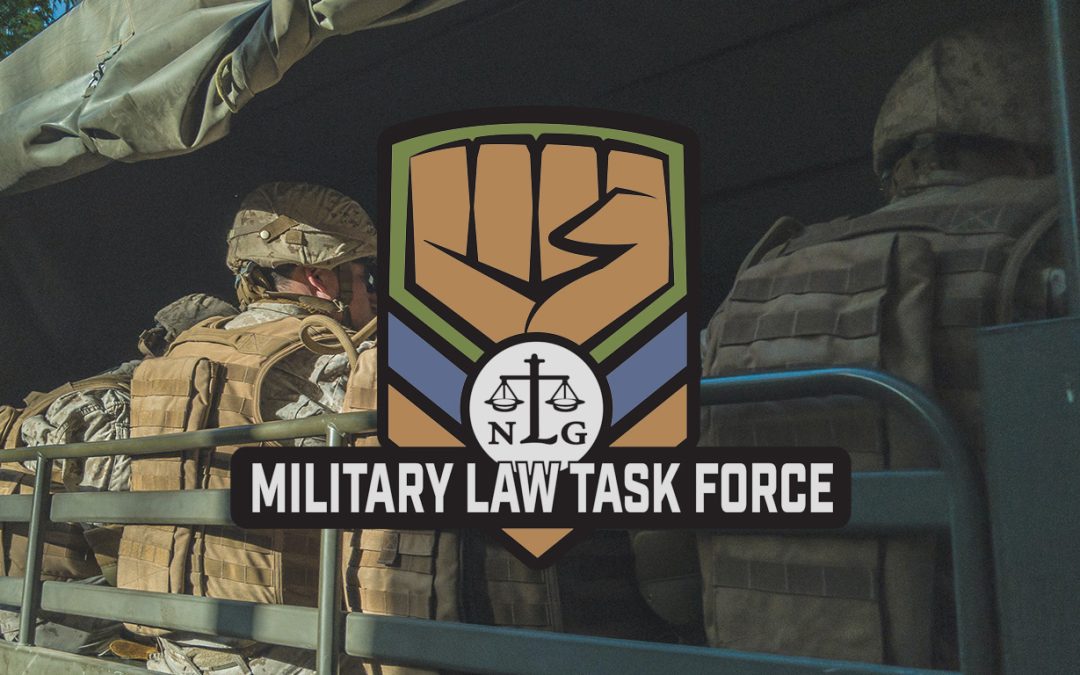By Emily Gallagher
In this article I discuss the issues raised by the enlistment of a 17-year-old minor in the military. I explain the process by which minors can enlist, and discuss how to advocate for the discharge of such minors based on the proposition that they are legally entitled to disaffirm their enlistment contracts before reaching the age of majority. I cover the discharge called Entry-Level Separation (ELS), which is sometimes used to discharge minors who wish to disaffirm their contracts. I also explain the problems with relying on ELS, including group pressure that prevents minors from seeking an ELS, and the discretionary nature of this discharge. In the final section I describe the barriers that have thus far prevented a judicial challenge to a minor’s enlistment and possible ways they could be avoided.
Minority Enlistment
Under 10 U.S.C.A. § 505, seventeen-year-olds can enlist in the military if they have the consent of their parents or guardians. The statute specifies,
“The Secretary concerned may accept original enlistments . . . [of] persons who are not less than seventeen years of age. However, no person under eighteen years of age may be originally enlisted without the written consent of his parent or guardian, if he has a parent or guardian entitled to his custody and control.”1
However, minors cannot be processed into any branch of the Armed Forces if one of their parents or guardians objects to the enlistment.2 On the other hand, only one parent or guardian’s signature is required if only one “can be reasonably obtained,” and the affirmative consent of each parent is not required to process an enlistment.3 Instead, it is the responsibility of the objecting parent to affirmatively object to the enlistment.4 This objection must be made in writing within 90 days of the minor’s enlistment.5
Because a recruiter is under no obligation to ensure that a parent who does not sign the enlistment contract does not object beyond the requirement that they provide an explanation as to why the signature cannot be “reasonably obtained,” it is quite possible for an objecting parent who is away on a trip or otherwise unavailable to miss his or her opportunity to object due to expiration of of the 90-day limitation period. Similarly, a forged parental signature will become irrelevant and the enlistment contract valid if the other parent does not discover the enlistment and object within 90 days.
Worth noting is that the 90-day period is not a waiting period during which parents who previously consented can withdraw their consent.6 A minor’s enlistment can only be voided if a parent objects and the minor enlisted without valid parental consent in the first place.7 Therefore, the 90-day period serves only as opportunity for an objecting parent, (whose objection would have prevented the enlistment in the first place), to step forward and voice his or her objection. Thus, 10 U.S.C.A. § 1170 is analogous to a statute of limitations after which an invalid enlistment (due to lack of parental consent) becomes valid; the defect (lack of parental consent due to an objecting parent) is waived. Because an invalid enlistment due to lack of parental consent is “waived” 90 days after enlistment, a 17-year-old who does not wish to be in the military and whose parents do not consent to his or her enlistment can still be stationed on active-duty and deployed.
Military remedy
If a minor enlisted with valid parental consent and cannot therefore be discharged within 90 days of enlistment, it is possible that he or she could be granted an Entry-Level Separation (ELS), a discretionary discharge that can be granted to service members while they are in entry-level status in any branch of the Armed Forces.8 An enlisted person is in entry-level status for the first 180 days of active duty, including training.9 Entry-level status begins on Day One of boot camp.
In addition to being in entry-level status, an enlisted person must be deemed unsatisfactory by his or her command in order to be given an ELS. The standards for an ELS vary slightly between branches of service. In the Air Force, for example, a service member may be separated under an ELS “when their unsatisfactory performance or conduct shows they are not qualified to be productive members of the Air Force.”10 In the Army, an ELS may be warranted “on the grounds of unsatisfactory performance and/or unsatisfactory conduct.”11 For the Coast Guard, an ELS is warranted if a service member “[d]emonstrates poor proficiency, conduct, aptitude or unsuitability for further service.”12 The Marine Corps permits an ELS “if the member is unqualified for further service by reason of entry level performance and/or conduct.”13 The Navy criteria mirrors those of the Marine Corps.
In the above-cited sections of their respective separation manuals, all branches of service provide a non-exhaustive list of conduct that demonstrates, with varying degrees of specificity, unsuitability for service.14 These lists include lack of reasonable effort, lack of self-discipline, unwillingness to meet performance standards, failure to adapt to the Military environment, and minor disciplinary infractions.15
Due to the significant amount of command discretion in granting an ELS, it remains a discretionary discharge granted only after a service member has received a counseling statement as to his or her failure to meet Service standards.16
For a 17-year-old who wants to be separated from the military, an ELS is only an option if the minor’s command is convinced that s/he cannot meet Service standards.17 No regulations permit a service member to be granted an ELS simply by asking for one, even if the member is 17. However, an ELS may be granted in this situation on the grounds that requesting separation shows a lack of willingness to conform to military life, a lack of self-discipline, or one of the other criteria.
However, because boot camp and basic training emphasize conformity and are notoriously difficult, commanders may be disinclined to grant an ELS to a service member requesting one. This could be due to a sense that all service members struggle in boot camp and many have a passing desire to give-up. Additionally, the emphasis on conformity may deter a service member from seeking an ELS or behaving in a way that would warrant a counseling statement and ELS.
As described by an Army lieutenant colonel, “group pressures to conform are substantial, and failure to conform results in group sanction.”18 Group cohesion is critical to military life, and central to cohesion is an individual’s “desire to submit to group norms.”19 This pressure to conform is extreme peer pressure and can prevent service members from breaking with the majority and seeking an ELS, especially when they fear that the group will be punished for their actions.
The discretionary nature of an ELS, the sense that boot camp is hard for everyone, and the emphasis on cohesion and conformity in training and military life in general can lead a 17-year-old to remaining in the Service beyond entry-level status and missing the opportunity to be granted an ELS.
Judicial remedy
Because an ELS is not available to every 17-year-old enlistee wishing to leave the military, some may seek to be released from their enlistment contracts through judicial process. Challenges to military enlistment are heard in federal court through a habeas corpus petition.20
The main barrier to judicial remedy for such a minor enlistee is the mootness doctrine. Article III requires that a case or controversy exist throughout all stages of a judicial proceeding so that “the parties . . . continue to have a ‘personal stake in the outcome’ of the lawsuit.”21a willingness to file habeas corpus proceeding can certainly indicate that a person “will not adapt socially or emotionally to military life,” e.g. AR 635-200, 11-3a.(3)(a), such a minor will likely be discharged before the proceeding takes place. By discharging the complaining minor, the military moots the habeas petition, removing the minor’s stake in the outcome of the proceeding.
The legal significance of mooting the habeas petition is that doing so would prevent a judicial decision that a minor’s enlistment contract is voidable. Thus, a minor who is interested in not only being discharged but also ensuring that other enlisted minors who change their mind are able to void their contracts may wish to proceed with his or her habeas petition to create precedent. To do so, the minor would have to argue that either an exception to mootness should apply or that, despite having been discharged, s/he retains a sufficient stake in the outcome of the proceeding to satisfy Article III.
Minors seeking to have their enlistment contract voided on a habeas petition would have to argue that they face negative consequences as a person who was discharged from the military that they would not suffer if their contract were void.22 If the minor were not given an ELS and were instead given a discharge with a character of service designation that is less than honorable, s/he could argue that such a discharge would inhibit future employment prospects.
The well-recognized exception to the mootness doctrine, for injuries that are capable of repetition but evade review, is clearly not applicable to the case of a minor wishing to void an enlistment contract, because to avail oneself of the exception, the injury must be capable of repetition against the party seeking relief, not just capable of repetition in general.23 Obviously, it is extremely unlikely that a minor who enlists in the military, seeks habeas relief to have her contract declared voidable, voids it, would then re-enlist and again wish to void the contract. Therefore, the capable-of-repetition-yet-evading-review exception to the mootness doctrine is of no use in this situation.
Finally, if the habeas petition were not mooted by a subsequent discharge and was allowed to proceed, the minor could argue that he or she should be able to void the enlistment contract based on the infancy doctrine. The modern Restatement rule is that contracts made with a minor are voidable by the minor either before they reach the age of majority or within a reasonable time thereafter.24 The infancy doctrine is well-accepted and widely applied as “one of the oldest and most venerable of our common law traditions.”25
However, the Supreme Court held 75 years ago that the infancy doctrine is not applicable to contracts relating to military service, relying on a case that is now more than 100 years old.26 In Williams, the Court held that a minor as young as 14 can enlist in the military, and the enlistment contract is not voidable by either the minor or the minor’s parents.27
The Supreme Court has not considered the issue since its decision in Williams, but district courts have. In Lonchyna v. Brown, 491 F. Supp. 1352, (N.D. Ill. 1980), the court considered whether an enlistment contract entered into by a 19-year-old in 1969 was voidable due to minority.28 Finding that the minor subsequently affirmed the contract after reaching the age of 21, the court stated that “[i]t is elementary that while a minor may avoid his contracts, he must do so within a reasonable time after reaching his majority.”29 The court appears to take for granted the notion that a minor may disaffirm his enlistment contract so long as he does so within a reasonable amount of time and does not reaffirm after reaching the age of majority.30
The assumption made by the Lonchyna court is well-founded. To hold that a minor may not disaffirm their enlistment contract while still a minor or within a reasonable time after attaining the age of majority would be contrary to “elementary” contract law.31 It would also require a court to rely on a case holding that 14-year-olds can be bound by their enlistment contracts, which is strikingly outdated given that the statutory age for enlistment has been raised to 17.32
The law’s concern with protecting minors from their own mistakes is well taken in the military context. As all the separation manuals for all branches of services state, “[m]ilitary service is a calling and is not like any civilian occupation.”33 Some minors may be sufficiently mature to make the decision to sign an enlistment contract and be bound by it. For such minors, the law allows enlistment with parental consent at the age of 17.34 For other minors, the minority doctrine exists and is just as applicable to an enlistment contract as with any other contract, if not more so due to the extremely high stakes of enlistment.
Conclusion
A minor wishing to void his or her enlistment contract will likely be granted an entry-level separation before given the opportunity to challenge the contract in court using the minority doctrine. However, this does not prevent minors from being required to serve when they and their parents object, because the entry-level separation is discretionary and many minors are likely too afraid to seek one anyway.
The main barrier to a definitive determination that the infancy doctrine applies to enlistment contracts is the routine discharge of minors willing to challenge their enlistment in court, which moots their claims. This practice prevents other enlisted minors from being able to disaffirm with confidence, keeping them in service when they and their parents want them separated.
Emily Gallagher graduated this month from UC Hastings, where she volunteered for the Bay Area Military Law Panel student military counseling program. She has worked for Swords to Plowshares advocating for veterans’ benefits and for the Animal Legal Defense Fund litigating on behalf of animals.
Endnotes
1. 10 U.S.C.A. § 505.
2. OPNAVINST 1100.4C; AFI 36–2003 (I); MCO 1100.75D; COMDTINST 1100.2E.
3. Id.
4. 10 U.S.C.A. § 1170.
5. Id.
6. 10 U.S.C.A. § 1170.
7. Id.
8. DoD Directive 1332.14; NAVPERS 15560D; MCO P1900.16F; COMDTINST M1000.4; AR 635-200; AFI 36-3208.
9. Id.
10. AFI 36-3208, 5.22.
11. AR 635-200, 11-2.
12. COMDTINST M1000.41.B.19.a.(1)(b).
13. MCO P1900.16F, 6205.1.
14. Id.
15. Id.
16. AFI 36-3208, 5.23; AR 635-200, 11-4.1.B.19.e; MCO P1900.16F, 6205.4; NAVPERS 15560D,1.
17. Id.
18. Lieutenant Colonel Robert Reilly, US Army, The Darker Side of the Force: The Negative Influence of Cohesion, Military Review, March-April 2001, at 58.
19. Id. at 59.
20. Irby v. U.S., Dept. of Army, 245 F. Supp. 2d 792, 795 (2003).
21. Lewis v. Continental Bank Corp., 494 U.S. 472, 477-478 (1990).
22. Carafas v. LaVallee, 391 U.S. 234, 237 (1968).
23. Weinstein v. Bradford, 423 U.S. 147, 149 (1975).
24. Restatement (Second) of Contracts § 14 (1981).
25. Halbman v. Lemke, 99 Wis. 2d 241, 245 (1980).
26. United States v. Williams, 302 U.S. 46, 48–50 (1937); Morrissey v. Perry, 137 U.S. 157 (1890).
27. Id. at 49.
28. Id. at 1353.
29. Id.
30. See id.
31. 491 F. Supp. at 1353.
32. 10 U.S.C.A. § 505.
33. AFI 36-3208, 5.23.
34. 10 U.S.C.A. § 505.



